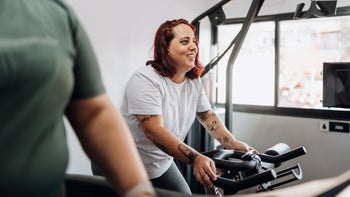
7 Proven Health Benefits of Squats
Key takeaways:
Squats can help you build strength in your legs and core, enhance mobility, and improve your performance in sports and daily activities.
Variations make squats suitable for beginner and advanced exercisers.
It's important to learn correct squat technique to avoid injuring yourself.

Squatting is a foundational movement you make daily without even thinking about it. For example, when you bend down to pick up something or sit on the toilet, you’re doing a squat.
There are several reasons to add squats to your workouts. Squats can help you move better in daily life and improve your performance in sports. Plus, they’re easy to do anywhere — no fancy equipment or gym membership required. All you need is a few tips to help you do them safely and effectively.
What are the benefits of squats?
Squats are a compound strength training exercise. And they offer a variety of health benefits for people of all ages and fitness levels. Here are seven advantages of practicing this classic body-weight exercise regularly.
Search and compare options
1. Squats strengthen your lower-body muscles
Squats target all the major muscle groups of the lower body, including:
Glutes: The gluteal muscles (butt muscles) include the gluteus maximus, medius, and minimus. Together, these muscles are primarily responsible for keeping the body erect and helping to propel it forward.
Hamstrings: The hamstrings are located along the back of the thighs and include three muscles. They help you with activities such as standing up, jumping, and sprinting.
Quadriceps: Also called quads, this group of four muscles along the front of the thighs helps straighten the legs and stabilize the kneecaps.
Calves: The calf muscles are found on the back of the lower legs and help flex the foot and ankle. These muscles are essential for running and jumping.
2. Squats increase your core strength
Your core is your midsection, which includes your abdominals, obliques, and lower and mid-back muscles. These essential muscles help stabilize your spine. And they allow you to perform movements like bending forward, backward, and side to side. They are also essential for torso rotation.
Squats might not come to mind first when you think of strengthening your core. But the exercise activates these midsection muscles, especially the erector spinae muscles, which support the spine. In fact, squats may be more effective than planks for increasing core strength. And both exercises strengthen the abdominals and obliques.
3. Squats improve your posture, balance, and mobility
Strong leg and core muscles are crucial for proper posture and balance. Your posture refers to how you hold your body upright, both while moving and remaining still. Good posture promotes a healthy musculoskeletal system. It can help prevent back pain, improve breathing and digestion, and enhance balance. And having good balance reduces your risk of falls and other injuries, making your everyday activities easier to perform.
Mobility refers to the ability of your joints to move through a full range of motion. Practicing squats may improve range of motion in your hip, knee, and ankle joints. Maintaining mobility increases synovial fluid, which lubricates your joints, and helps reduce your risk of injury in daily activities and sports.
Read more like this
Explore these related articles, suggested for readers like you.
4. Squats can boost your athletic performance
Lower-body strength, balance, and mobility all play a role in your sports performance. One study found that back squats are one of the most effective exercises to boost athletic performance.
Back squats, which involves a barbell resting behind the neck, are the most commonly performed variation of weighted squats. The move trains several muscle groups to work together. And it strengthens muscles that are essential for explosive movements like running and jumping.
5. Squats keep your bones and joints strong
When you do strength training exercises like squats, your muscles adapt to the resistance from your body weight. As part of that process, they may grow bigger and stronger. Your bones respond in a similar manner. When your bones are regularly exposed to force from resistance exercises, they may adapt by increasing bone density.
A 2017 study suggests that weight training in adolescence prevents age-related bone disorders like osteoporosis. But doing squats and other weight-bearing exercises throughout adulthood can still preserve bone mass and keep your bones and joints strong.
6. Squats burn more calories
One of the many benefits of strength training is that it supports healthy weight loss and maintenance. That's because the more muscle mass you have, the more calories your body burns while at rest. Strength training burns fewer calories than aerobics. But you can increase the calories you burn during your strength training workouts by doing compound exercises like squats.
Compound exercises target more than one muscle group at a time. The more muscles you activate at once, the more calories you’ll burn. And with squats, you activate your core and lower-body muscles. You can combine squats with other compound exercises — such as lunges, deadlifts, rows, and pull-ups — to get the maximum burn for your buck.
7. Squats can boost your confidence, and you can do them almost anywhere
Squats are a simple, equipment-free way to build strength and improve sports performance. And you can reap all the benefits from the comfort of your home. Plus, you can increase the challenge with multiple squat modifications. You’ll build strength, muscle, balance, and mobility, and gain confidence along the way.
How do you do a squat?
Proper form is critical to preventing injuries and reaping the benefits of squats. Although there are several variations of squats, here is the basic foundational technique. Be sure to master this move before you add weight or do other challenging variations.
Stand with your feet a little wider than hip-distance apart, your spine straight, and your shoulders aligned over your hips. Pull your shoulders down and back, and keep your head up and your chest open throughout the movement.
Contract your core muscles and shift your body weight back onto your heels.
Slowly bend your knees, bringing your hips back and down as if you’re sitting in a chair. Keep your knees aligned behind your toes.
Continue to lower yourself until your thighs are parallel to the floor. You can go lower if your knee and ankle mobility allows. But only go as low as you can without rounding your back or lifting your heels off the floor.
Maintain a neutral posture as you extend through the knees to return to the starting position.
Repeat 10 to 15 times.
What are the best squat modifications?
There are many squat variations suitable for beginners and advanced athletes alike. Here are a few to get you started.
Chair squat
The chair squat is an excellent variation for people with limited mobility or beginners who are still developing lower-body strength. You can use any height seat: A higher seat makes this exercise easier, and a lower seat increases the challenge.
Stand directly in front of a chair with your feet a little wider than hip-distance apart. Keep your chest open and your back straight.
Lift your arms to shoulder height with your palms facing the floor.
Bend your knees as you slowly lower yourself down, reaching your hips back and shifting your weight toward your heels. Keep your knees parallel and aligned behind your toes.
Keep lowering down until you tap the seat and lift back up to the starting position.
Repeat 10 to 15 times.
Squat jump
The squat jump can help you build explosive power. It's an effective modification for incorporating more cardio into your strength training session.
Stand with your feet hip-distance apart and your hands at your sides.
Contract your core muscles and pull your shoulders down and back.
Shift your weight onto your heels and lower your hips down and back.
Keep your back flat as you bend your knees and lower yourself down as far as you can. Hold the squat for a brief pause.
Press up through your feet to extend your legs and jump. Your feet should come up a few inches off the floor.
Land with a controlled movement as you bend your knees and immediately lower back into a squat.
Repeat 10 to 12 times.
Goblet squat
This is a more advanced version of the traditional squat. It requires a dumbbell or kettlebell. You can also add resistance with items you have at home, such as a water jug. Ease into this move by starting with smaller weights or household items.
Start with your back straight, shoulders down, and feet a little more than hip-width apart.
Hold the end of a dumbbell in a vertical position directly in front of your chest.
Squeeze your abdominals to engage your core.
Keep your elbows at your sides as you bend your knees, shift your hips back, and lower into a squat.
Continue lowering into the squat until your hips are beneath your knees.
Press into your heels as you lift up and return to the starting position.
Repeat 10 to 12 times.
The bottom line
Squats are a versatile and effective strength training exercise for people at every fitness level. When done correctly, they can build muscle strength, improve sports performance, and enhance mobility. And you can do this foundational movement almost anywhere, making it a convenient way to boost athletic performance and confidence without stepping into a gym.
Why trust our experts?



References
American Council on Exercise. (n.d.). Bodyweight squat.
American Council on Exercise. (n.d.). Goblet squat.
American Council on Exercise. (n.d.). Squat jump.
American Council on Exercise. (2013). Core anatomy: Muscles of the core.
Binstead, J. T., et al. (2022). Anatomy, bony pelvis and lower limb, calf. StatPearls.
Boston University. (n.d.). Exercise 1: The squat.
Davis, D. D. (2015). Leg maintenance: Protecting your quads and hamstrings. National Federation of State High School Associations.
Hong, A. R., et al. (2018). Effects of resistance exercise on bone health. Endocrinology and Metabolism.
Klika, B. (2018). 4 workout time wasters (and what to do instead!). American Council on Exercise.
Kim, S-H., et al. (2015). Lower extremity strength and the range of motion in relation to squat depth. Journal of Human Kinetics.
Kinucan, P., et al. (n.d.). Controversies in metabolism. University of New Mexico.
Koch, A. (n.d.). 3 reasons strong glutes are important. Methodist Health System.
Kovar, E. (2015). How posture affects breathing. American Council on Exercise.
MedlinePlus. (2017). Guide to good posture.
Myer, G. D., et al. (2014). The back squat: A proposed assessment of functional deficits and technical factors that limit performance. Strength and Conditioning Journal.
NIH Osteoporosis and Related Bone Diseases National Resource Center. (2018). Exercise for your bone health.
Piedmont Healthcare. (n.d.). Are squats the best exercise?
Rodgers, C. D., et al. (2022). Anatomy, bony pelvis and lower limb, hamstring muscle. StatPearls.
Santos, L., et al. (2017). Exercise and bone health across the lifespan. Biogerontology.
Szczygiel, E., et al. (2017). Musculo-skeletal and pulmonary effects of sitting position - A systematic review. Annals of Agricultural and Environmental Medicine.
University of Connecticut. (n.d.). Learn: Gluteal region.
Van den Tillaar, R., et al. (2018). Comparison of core muscle activation between a prone bridge and 6-RM back squats. Journal of Human Kinetics.
Vermont Paddle Fitness. (2020). Joint stability/mobility workout.



























